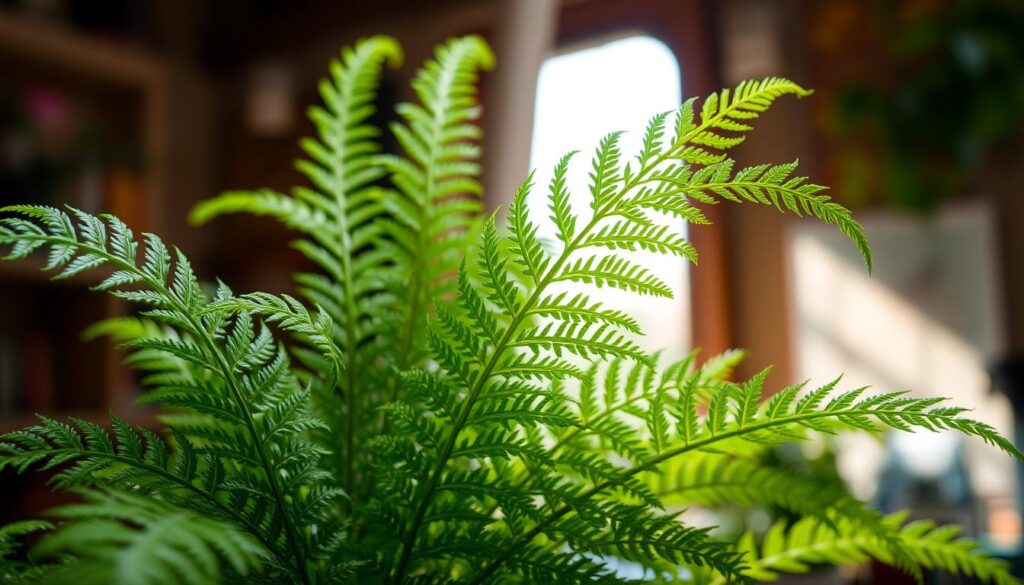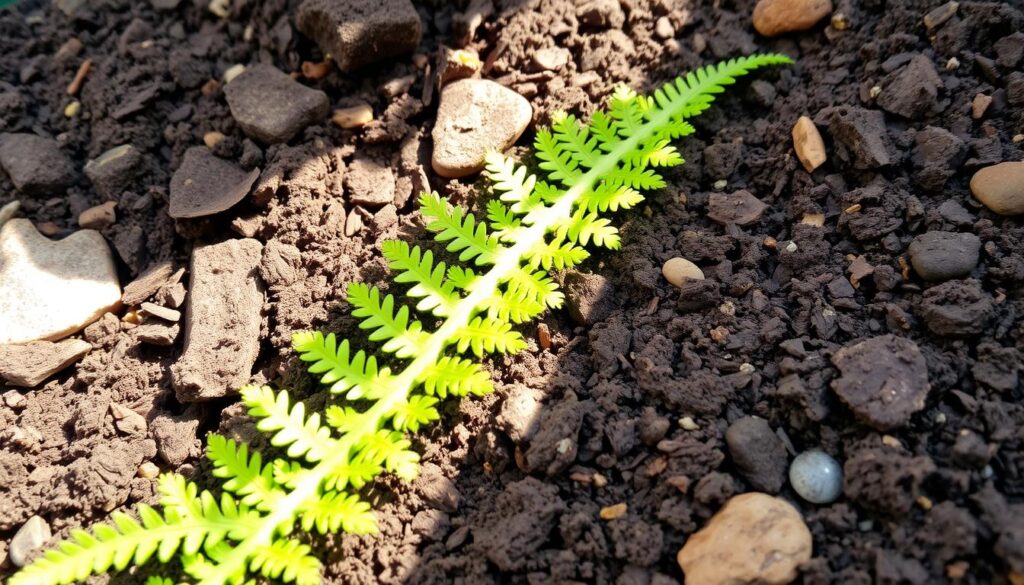Ever thought about growing the beautiful Sprengeri fern (Asparagus densiflorus ‘Sprengeri’) indoors? It looks like a fern but is actually a member of the Asparagaceae family. This guide will show you how to care for these plants indoors. We’ll cover watering, light, soil, and maintenance to help you grow them well.
Key Takeaways
- Sprengeri ferns are not true ferns but belong to the Asparagaceae family
- They thrive in bright, indirect light and need well-draining soil
- Proper watering and humidity levels are crucial for healthy growth
- Regular fertilization and pruning help maintain the fern’s lush appearance
- Sprengeri ferns can be propagated through division or seed sowing
Introduction to Sprengeri Ferns
The Sprengeri fern, also known as the asparagus fern or emerald fern, is a favorite indoor plant. It’s loved for its lush, trailing leaves and ability to purify the air. Even though it’s called a fern, it’s actually part of the Asparagaceae family.
This easy-to-care-for plant comes from South Africa’s humid forests. It brings a tropical look to any room.
Origins and Natural Habitat
The Sprengeri fern, known scientifically as Asparagus densiflorus ‘Sprengeri’, comes from South Africa’s coast. It loves the shaded, moist areas of the forest floor. There, it spreads out as a ground cover.
Botanical Classification
Even though it’s called a fern, the Sprengeri fern isn’t one. It’s actually part of the Asparagaceae family. This family includes plants like edible asparagus, but they’re not closely related.
Common Names and Varieties
This plant is also known as the emerald fern, plume asparagus, and foxtail fern. The most well-known variety is Asparagus densiflorus ‘Sprengeri’. But there are others like ‘Myers’ (foxtail fern) and ‘Sprengeri Compacta’ (a smaller version).
“The Sprengeri fern is a low-maintenance, air-purifying plant that can add a touch of tropical elegance to any indoor space.”
Understanding Sprengeri Fern Growth Habits
Learning about Sprengeri ferns is crucial for their care. Known as asparagus ferns, they grow quickly. Their stems and leaves can spread up to 4 feet wide and 3 feet tall.
The “leaves” of Sprengeri ferns are actually cladodes, which look like leaves but are flat. True leaves are small and hidden near the base. As they grow, they may develop small thorns.

Sprengeri ferns grow fast and spread out. They’re great for hanging baskets, containers, and as groundcover indoors. Their stems grow in an arch, making them look lush and textured.
Knowing about sprengeri fern growth patterns and asparagus fern characteristics helps them thrive indoors. By meeting their needs, you can enjoy their beauty and vibrant foliage for years.
Essential Sprengeri Fern Care Requirements
Proper care is key to keeping your Sprengeri fern looking its best. These plants need specific temperatures, humidity, and light to thrive. Gardeners should pay attention to these needs to create the best growing space.
Temperature Requirements
Sprengeri ferns do well in temperatures between 55°F and 70°F. It’s important to keep their environment stable. Avoiding big changes in temperature helps them stay healthy and grow well.
Humidity Needs
These ferns love high humidity, around 60-70%. To meet their asparagus fern humidity needs, mist them often. You can also place them in humid spots, like bathrooms.
Light Conditions
Sprengeri ferns need bright, indirect sunlight. They should be in places with lots of natural light. But, direct sunlight can burn their leaves.
“Consistent care in these areas promotes lush, healthy growth for your Sprengeri fern.”
By giving your Sprengeri fern the right temperature, humidity, and light, it will thrive. This will add green beauty to any room.
Optimal Soil Conditions and Potting Mix
For healthy sprengeri ferns, soil matters a lot. They love well-draining, slightly acidic soil with a pH of 6.5-6.8. For plants in pots, a light, airy mix is best.
Mixing 1 part potting soil with 1 part perlite is perfect. It lets roots breathe and plants grow well.
For asparagus fern plants, a mix of 20% clay, 40% sand, and 40% silt works great. It’s like their natural home, giving them the right nutrients and moisture.
| Soil Characteristic | Preferred Range |
|---|---|
| pH | 6.5-6.8 |
| Soil Composition | 1 part potting soil, 1 part perlite or 20% clay, 40% sand, 40% silt |
| Drainage | Well-draining |
By giving them the right sprengeri fern soil preferences and asparagus fern potting mix, you help them thrive. This ensures they stay healthy and look great for a long time.

Watering Schedule and Techniques
Keeping the right moisture is key for your sprengeri fern or asparagus fern to grow well. These plants need specific watering needs to thrive.
Signs of Overwatering
Don’t overwater your fern. Signs like yellow fronds, wilted leaves, and root rot mean it’s getting too much water. Make sure the soil drains well and wait until the top 2 inches dry before watering again.
Signs of Underwatering
If your sprengeri fern or asparagus fern is underwatered, its fronds might turn brown and crisp. It needs consistent moisture, especially when it’s warmer. But, water less in winter when it grows slower.
To keep your fern happy, water it deeply when the top 2 inches of soil feel dry. This ensures the roots get enough water without drowning the plant. By watching for these signs and adjusting your watering, your indoor water garden will flourish.
“Consistent moisture is the key to a healthy, vibrant sprengeri fern or asparagus fern. Avoid letting the soil dry out completely, but also be mindful not to overwater and risk root rot.”
Light Requirements and Placement
Sprengeri ferns, also known as asparagus ferns, love bright, indirect light. They grow best near east-facing windows where they get soft morning sun. If you have south or west-facing windows, place them a few feet back to avoid harsh sunlight.
If your fern’s fronds look pale, it needs more light. On the other hand, if they scorch or turn yellow, it’s getting too much sun. Move your fern to find the perfect spot for it to stay green and healthy.
When choosing where to put your asparagus fern indoors, think about your home’s natural light. You want enough light but not too much direct sun. Watch how your fern reacts and adjust its spot as needed to create the best light for it.

“Sprengeri ferns are adaptable and can tolerate a range of light conditions, but they truly thrive when given the right balance of illumination.”
Fertilization and Nutrient Needs
Proper fertilization is key for your sprengeri fern to stay healthy and green. Use a balanced, water-soluble fertilizer at half strength. Feed your fern monthly in spring and summer. For plants in containers, fertilize weekly during their growth peak.
In autumn and winter, cut back on fertilizing. Watch how your fern reacts and adjust as needed. Too much fertilizer can cause yellow leaves. By paying attention, you’ll give your fern the right sprengeri fern fertilization and asparagus fern nutrients for best growth and color.
Types of Fertilizers
- Water-soluble balanced fertilizer (e.g., 20-20-20 or 10-10-10)
- Liquid or granular organic fertilizers
- Slow-release fertilizer pellets
Application Schedule
- Spring and summer: Monthly or weekly (for container plants)
- Autumn and winter: Reduce frequency
- Monitor plant response and adjust as needed
| Fertilizer Type | Application Frequency | Dilution Rate |
|---|---|---|
| Water-soluble balanced | Monthly (Spring/Summer), Reduce in Fall/Winter | 1/2 strength |
| Liquid or granular organic | Monthly (Spring/Summer), Reduce in Fall/Winter | As per manufacturer instructions |
| Slow-release pellets | Apply every 2-3 months | Follow package directions |
“Vigilant monitoring and responsive adjustments to your sprengeri fern’s fertilization needs are the keys to maintaining its vibrant, healthy appearance.”
Pruning and Maintenance Tips
To keep your sprengeri fern looking great, you need to prune and care for it regularly. One important step is to cut off any yellowed, damaged, or dead fronds. This helps promote new, healthy growth.
When you prune your sprengeri fern, use sharp scissors or pruning shears. Cut the stems at the base, but don’t remove more than one-third of the plant’s leaves at once. This way, the fern can recover well without getting stressed.
- Remove any yellow, brown, or damaged fronds to keep the plant looking good.
- Don’t cut more than 33% of the fern’s leaves to avoid shocking it or slowing its growth.
- Throw away the cut parts to stop pests or diseases from spreading.
Regular pruning not only makes your sprengeri fern look better. It also helps it grow fuller and bushier. By cutting back stray or too-long stems, you can shape the plant to fit your space.

“Proper pruning and maintenance are essential for keeping your sprengeri fern healthy and thriving indoors.”
Also, make sure your asparagus fern has the right growing conditions. This includes well-draining soil, the right amount of water, and plenty of indirect sunlight. With a little care, your sprengeri fern will give you beautiful, green leaves for many years.
Repotting Guidelines
Keeping your indoor Sprengeri fern (Asparagus Densiflorus ‘Sprengerii’) healthy means repotting it regularly. This plant loves to grow and needs room for its roots. It also needs fresh, nutrient-rich soil to thrive.
When to Repot
Repot your Sprengeri fern every year or when you see roots through the pot’s holes. This means it’s time for a bigger home.
Repotting Process
- Look for a pot that’s 1-2 inches wider than your current one.
- Take the fern out of its pot carefully to avoid harming its roots.
- You can split the fern into parts if you want, making sure each part has good roots.
- Use a potting mix that drains well and is rich in nutrients, perfect for ferns.
- Put the fern (or parts) into the new pot, making sure the soil level is the same.
- Water the fern well after repotting to help it settle and grow new roots.
Spring is the best time to repot your Sprengeri fern. This lets it grow well in the new pot during the warmer months.
“Proper repotting ensures your Sprengeri fern can thrive for years to come, providing a lush, cascading display of foliage in your indoor space.”
Common Pests and Diseases
Sprengeri ferns, also known as asparagus ferns, can face pests and diseases if not cared for right. They might get issues like spider mites, aphids, whiteflies, and mealybugs if their environment isn’t good.
To fight pests, treat the affected spots with insecticidal soap or neem oil. These natural options can get rid of sprengeri fern pests safely.
It’s also important to watch for root rot. This can happen if you water too much or if the soil doesn’t drain well. Make sure to water and keep humidity right to avoid this and keep your fern healthy.
Regular checks and quick action can help spot and fix asparagus fern diseases or pest issues early. This way, you can keep your indoor plant happy and healthy.

“Vigilance and proper care are key to keeping your sprengeri fern free from common pests and diseases.”
Propagation Methods and Techniques
Propagating sprengeri ferns, also known as asparagus fern, is rewarding. It can grow your indoor plant collection. You can use two main methods: division and seed propagation.
Division Method
Division is a simple way to propagate sprengeri ferns. Do it in the spring or early summer when the plant is growing. Remove the plant from its pot and separate the roots into sections.
Make sure each section has healthy roots and shoots. Plant them in a potting mix that drains well. Water them well to help them grow.
Seed Propagation
Seed propagation is for the adventurous. Collect the ripe, red berries and extract the seeds. Scarify the seeds to help them absorb water, then soak them overnight.
Sow the seeds in moist, well-draining potting mix. Keep the soil moist until they germinate, which takes about 4 weeks.
Division is quicker and easier, but seed propagation is rewarding. Choose the method that suits you best. Proper care during propagation will help your new asparagus fern plants grow well.
| Propagation Method | Time to Maturity | Success Rate | Ease of Propagation |
|---|---|---|---|
| Division | 2-4 weeks | High | Easy |
| Seed Propagation | 4-12 months | Moderate | Moderate |
Indoor vs Outdoor Growing Considerations
The Sprengeri fern, also known as the Asparagus fern, can grow indoors or outdoors. It depends on the climate and growing conditions. For indoor growth, Sprengeri ferns need consistent humidity and protection from drafts. They thrive in temperatures around 70 degrees Fahrenheit and should avoid temperatures below 55 degrees Fahrenheit.
Outdoor planting is possible in USDA hardiness zones 9 to 11. However, gardeners should watch out for their invasive potential, especially in Florida, Texas, and Hawaii. In colder areas, growing them in containers that can move indoors during winter is best. This helps them survive and prevents aggressive spreading.
Indoor Sprengeri ferns need regular misting or a pebble tray to keep humidity high. Outdoor plants might get enough humidity naturally. But, all Sprengeri ferns should be checked for pests like spider mites, aphids, and mealybugs. They also need proper care to keep their leaves green and healthy.


